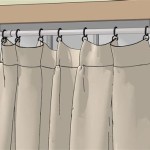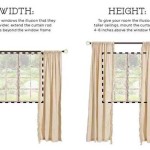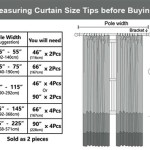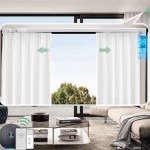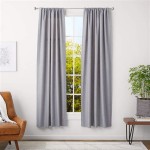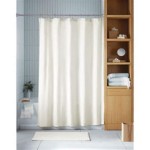What is a Rod Pocket Curtain?
A rod pocket curtain, also known as a pole top curtain or a heading tape curtain, is a type of window treatment characterized by a sewn-in pocket or casing at the top through which a curtain rod is inserted. This simple design allows the fabric to gather naturally on the rod, creating soft folds or ruffles. The rod pocket construction is one of the oldest and most common methods of hanging curtains, appreciated for its ease of installation and versatility in various decorating styles.
The defining feature of a rod pocket curtain is the channel created at the top edge of the fabric panel. This channel is formed by folding the top edge of the fabric over and stitching it down, leaving an opening wide enough to accommodate a curtain rod. The dimensions of the pocket can vary depending on the desired fullness of the curtain and the diameter of the rod being used. A wider pocket typically results in deeper, more pronounced folds, while a narrower pocket creates a tighter, more streamlined appearance.
Rod pocket curtains offer a distinctly different aesthetic compared to other curtain hanging methods like grommet tops or tab tops. The gathered fabric at the top creates a softer, more romantic look. This style is often seen in bedrooms, living rooms, and dining rooms where a relaxed and inviting atmosphere is desired. While often considered more traditional, rod pocket curtains can also be incorporated into modern and contemporary designs through the selection of appropriate fabrics and patterns.
Installation of rod pocket curtains is straightforward. The curtain rod is simply threaded through the pocket, and the rod is then mounted onto brackets attached to the wall or window frame. This simplicity makes rod pocket curtains a popular choice for homeowners who prefer a DIY approach to decorating. Because the curtain hangs directly from the rod, the hardware is often partially or completely concealed, further contributing to the clean and uncluttered look.
While the basic design of a rod pocket curtain remains consistent, variations exist to tailor the appearance and functionality. Some rod pocket curtains include a header or ruffle above the pocket, which adds visual interest and conceals the curtain rod slightly. Other variations incorporate pleating or shirring to create a more tailored or structured look. The choice of fabric, pattern, and color significantly impacts the overall aesthetic, allowing for customization to suit diverse decorating preferences.
Key Point 1: The Construction and Function of the Rod Pocket
The core of a rod pocket curtain lies in the construction of the pocket itself. It's crucial to understand how this pocket is made and how it influences the curtain's appearance and performance. The depth of the pocket, the type of stitching used, and the overall finishing details all contribute to the curtain's aesthetic appeal and functional durability.
The depth of the rod pocket directly influences the fullness and drape of the curtain. A deeper pocket allows for more fabric to gather on the rod, creating richer, fuller folds. This can be particularly desirable for sheer or lightweight fabrics, as it adds volume and prevents the curtain from appearing flat and lifeless. Conversely, a shallower pocket results in a cleaner, more streamlined look, which may be preferred for heavier fabrics or more minimalist designs. Generally, the depth of the pocket should be at least twice the diameter of the curtain rod to allow for easy threading and proper draping.
The stitching used to create the rod pocket should be strong and durable. A double hem or reinforced stitching is recommended, especially for heavier fabrics or curtains that will be frequently opened and closed. The seams should be neatly finished to prevent fraying and ensure a clean, professional appearance. The quality of the stitching is a key indicator of the overall quality and longevity of the curtain.
Another important aspect of the rod pocket construction is the consideration of a header or ruffle above the pocket. This additional fabric extends above the rod, concealing it from view and adding a decorative element. The header can be a simple plain band or a more elaborate ruffle or pleated section. The choice of header depends on the desired aesthetic and the overall style of the room. A header can add a touch of elegance and sophistication, particularly when paired with luxurious fabrics.
The rod pocket also impacts the ease of movement of the curtain along the rod. If the pocket is too tight or the fabric is too stiff, the curtain may be difficult to open and close smoothly. It is important to ensure that the rod can easily slide through the pocket without catching or bunching. Applying a fabric lubricant or silicon spray to the rod can help to improve the curtain's gliding action.
Key Point 2: Advantages of Using Rod Pocket Curtains
Rod pocket curtains offer several advantages that contribute to their popularity. These include ease of installation, cost-effectiveness, versatility in design, and ability to create a softer, more informal aesthetic. When weighing different curtain styles, it is important to consider these advantages in relation to specific needs and preferences.
One of the primary advantages of rod pocket curtains is the simple and straightforward installation process. Unlike curtains that require specialized hardware or complicated hanging systems, rod pocket curtains can be hung directly on a standard curtain rod. This makes them a popular choice for DIY enthusiasts and homeowners who prefer a hassle-free decorating experience. The ease of installation also contributes to the overall cost-effectiveness of rod pocket curtains, as it eliminates the need for professional installation services.
Rod pocket curtains are generally less expensive than other curtain styles, such as grommet tops or pleated curtains. The simple construction requires less fabric and less labor, resulting in lower manufacturing costs. This makes rod pocket curtains an attractive option for budget-conscious consumers who want to achieve a stylish and functional window treatment without breaking the bank. The availability of a wide range of affordable fabrics and patterns further enhances the cost-effectiveness of this curtain style.
Rod pocket curtains offer a high degree of versatility in design. They can be made from a wide variety of fabrics, ranging from lightweight sheers to heavy-duty blackout materials. They can also be customized with different patterns, colors, and embellishments to suit diverse decorating styles. This versatility allows homeowners to create a cohesive and personalized look that complements their existing decor. Rod pocket curtains can be used in any room of the house, from bedrooms and living rooms to kitchens and bathrooms.
The gathered fabric at the top of a rod pocket curtain creates a softer, more informal aesthetic. This is in contrast to the more structured and tailored look of pleated curtains or the sleek and modern look of grommet tops. The soft folds and ruffles of a rod pocket curtain can add warmth and character to a room, creating a welcoming and inviting atmosphere. This style is particularly well-suited for bedrooms and living rooms where a relaxed and comfortable ambiance is desired.
Rod pocket curtains also offer a degree of light control and privacy. The amount of light that is filtered through the curtain depends on the type of fabric used. Sheer fabrics allow plenty of natural light to enter the room, while heavier fabrics can block out light completely. The level of privacy provided by a rod pocket curtain also depends on the fabric. Thicker fabrics offer greater privacy, while sheer fabrics allow for visibility from the outside.
Key Point 3: Considerations When Choosing Rod Pocket Curtains
Choosing the right rod pocket curtains involves considering various factors, including the desired aesthetic, the type of fabric, the dimensions of the window, and the functionality required. Taking these factors into account ensures a successful outcome and a window treatment that meets both aesthetic and practical needs.
The desired aesthetic is a primary consideration when selecting rod pocket curtains. The overall style of the room, the color scheme, and the existing decor should all be taken into account. A traditional or romantic decorating style may call for soft, flowing fabrics with floral patterns or delicate embellishments, while a modern or minimalist style may require clean lines, solid colors, and simple designs. The choice of fabric, pattern, and color should complement the overall look and feel of the room.
The type of fabric used for rod pocket curtains significantly impacts their appearance, performance, and durability. Lightweight fabrics like linen or voile create a soft and airy look, allowing for ample natural light to enter the room. Heavier fabrics like velvet or brocade offer greater privacy and light control, and they can add a touch of luxury and sophistication. Blackout fabrics are ideal for bedrooms or media rooms where complete darkness is desired. The choice of fabric should be based on the desired level of light control, privacy, and aesthetic appeal.
Accurate measurement of the window is essential for ensuring a proper fit. The width of the rod pocket curtain should be at least twice the width of the window to allow for adequate fullness and draping. The length of the curtain should be determined by measuring from the top of the curtain rod to the desired hemline. Curtains can be hung to the sill, to the apron (just below the window frame), or to the floor. Floor-length curtains are generally considered more elegant and formal, while shorter lengths are more practical for kitchens and bathrooms.
The functionality of the rod pocket curtain should also be taken into account. If the curtain needs to be opened and closed frequently, a lightweight fabric that slides easily on the rod is recommended. If the curtain is primarily for decorative purposes, a heavier fabric with more elaborate embellishments may be preferred. Consider whether the curtains need to provide privacy, block out light, or insulate against heat or cold. The choice of fabric and lining should be based on these functional requirements.
The color and pattern of the rod pocket curtains can significantly impact the overall look and feel of the room. Light colors can make a room feel brighter and more spacious, while dark colors can create a more intimate and cozy atmosphere. Patterns can add visual interest and personality, but they should be chosen carefully to avoid overwhelming the space. Solid-colored curtains are a safe and versatile option that can complement a wide range of decorating styles. When in doubt, it is always best to choose a neutral color that blends seamlessly with the existing decor.

How To Install And Style Rod Pocket Curtains Sa

What You Need To Know About Rod Pocket Curtains My Blog

How To Make Rod Pocket Curtains Ofs Maker S Mill

Grommet Rod Pocket Or Back Tab Curtains What Should I Use Deconovo Uk

Rod Pocket Drapery Header Bestwindowtreatments Com

How To Make Rod Pocket Curtains Ofs Maker S Mill

How To Make Rod Pocket Curtains Simple And Elegant Diy Hello Sewing

What You Need To Know About Rod Pocket Curtains My Blog

Grommet Rod Pocket Or Back Tab Curtains What Should I Use Deconovo Uk

Set Of 2 Belgian Textured Linen Rod Pocket Sheer Window Curtain Panels Exclusive Home
See Also

